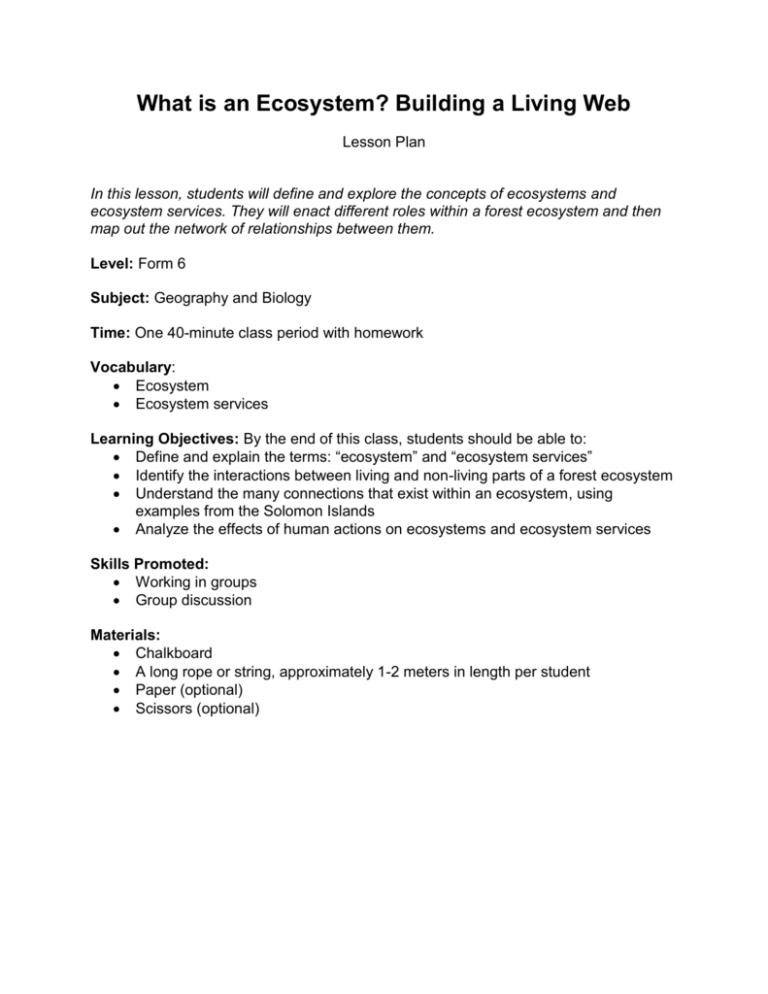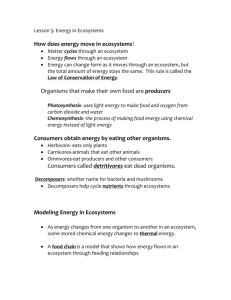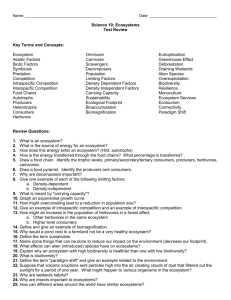
What is an Ecosystem? Building a Living Web
Lesson Plan
In this lesson, students will define and explore the concepts of ecosystems and
ecosystem services. They will enact different roles within a forest ecosystem and then
map out the network of relationships between them.
Level: Form 6
Subject: Geography and Biology
Time: One 40-minute class period with homework
Vocabulary:
Ecosystem
Ecosystem services
Learning Objectives: By the end of this class, students should be able to:
Define and explain the terms: “ecosystem” and “ecosystem services”
Identify the interactions between living and non-living parts of a forest ecosystem
Understand the many connections that exist within an ecosystem, using
examples from the Solomon Islands
Analyze the effects of human actions on ecosystems and ecosystem services
Skills Promoted:
Working in groups
Group discussion
Materials:
Chalkboard
A long rope or string, approximately 1-2 meters in length per student
Paper (optional)
Scissors (optional)
All reproduction or distribution must provide full citation of the original work and provide
a copyright notice as follows:
“Copyright 2013, by the authors of the material and the Center for Biodiversity and
Conservation of the American Museum of Natural History. All rights reserved.”
This material is based on work supported by the MacArthur Foundation.
Any opinions, findings and conclusions, or recommendations expressed in this material
are those of the authors and do not necessarily reflect the views of the American
Museum of Natural History, or the John D. and Catherine T. MacArthur Foundation.
2
What is an Ecosystem? Building a Living Web
INTRODUCTION
In this lesson, you will introduce your students to the concept of ecosystems.
Ecosystems are communities of living organisms that interact with each other and with
their nonliving environment (such as the surrounding rocks or water). The natural world
can be viewed as a series of ecosystems. The scale of an ecosystem can range from
an entire ocean system to the stomach of a bird.
Numerous types of ecosystems can be found within the Solomon Islands, including
forest ecosystems, grassland ecosystems, river ecosystems, and coral reef
ecosystems. These ecosystems are connected and interact with each other. People are
part of ecosystems, interacting with, using, and also changing both the living and
nonliving components of the ecosystems.
In this lesson, we focus on defining ecosystems by exploring the living and nonliving
parts of forest ecosystems. Students identify the interactions between living and nonliving parts of a forest ecosystem to illustrate the many connections that exist within an
ecosystem. These connections make possible ecosystem services, which are
everything an ecosystem does or provides that benefit human beings.
Using this lesson plan, you will guide students to:
Understand the concepts of ecosystems and ecosystem services
Identify interactions between living and non-living parts of a forest ecosystem
Understand the many connections that exist within an ecosystem, using
examples from the Solomon Islands
Analyze the effects of human interactions on ecosystems and ecosystem
services
3
This lesson plan is structured in three stages that reflect the learning objectives (above).
Times
Teacher’s Activity
Students’ Activity
ECOSYSTEMS:
LIVING & NON-LIVING
COMPONENTS
0:00-0:05 (5 Minutes)
Define ecosystem.
Brainstorm living and
non-living components of
a forest ecosystem.
ECOSYSTEM
COMPONENTS
INTERACT
0:05-0:20 (15 Minutes)
Organize activity:
Identify relationships
student “web” map of a within the forest
forest ecosystem.
ecosystem and build a
“web.”
ECOSYSTEM
RELATIONSHIPS
0:20-0:35 (15 Minutes)
Guide students as they Identify and describe
explore relationships
relationships between
between components
ecosystem components.
of the ecosystem
“web.”
LESSON SUMMARY
0:35-0:40
(5 Minutes)
Review the learning
objectives & lead a
class discussion.
Participate in class
discussion and reflection.
1. ECOSYSTEMS: LIVING AND NON-LIVING COMPONENTS (5 MINUTES)
Begin your exploration of ecosystems by giving students the following definition:
Ecosystems are communities of living organisms (plants and animals) that interact with
each other and with their nonliving environment (such as the surrounding rocks or
water).
Write “Forest Ecosystem” on the chalkboard and draw two boxes underneath – inside
one of the boxes write “living organisms” (or “plants and animals”) and write “nonliving
environment” in the other box.
Ask the students to consider a forest ecosystem and create a list of living organisms
(plants and animals) that are found in forest ecosystems and another list of nonliving
parts of the forest environment. Write the students’ answers on the board under the
appropriate box.
Note that the student answers might be broad (“birds”) or more specific (“kukuvoju”) –
both types of answers are welcome. Don’t forget – humans are important living
organisms and we are centrally connected to many ecosystems. Humans should be on
the list!
Example list of the components of a forest ecosystem:
4
Forest Ecosystem
Living Organisms
- birds
- trees
- insects
- bacteria
- spiders ...
Nonliving Environment
- rocks
- soil/ dirt
- air
- water …
2. HOW ECOSYSTEM COMPONENTS INTERACT (15 MINUTES)
** Note: This activity in this section requires a ball of string or rope approximately
20 meters in length (about 1-2 meters per student).
In this section, the students will each take on the role of a different component of a
forest ecosystem and together they will map out the network of relationships within the
forest ecosystem.
Have the students stand and form one large circle. Assign each student a unique role or
identity, drawing from the list of living and nonliving components of the forest ecosystem
that the class generated in Step 1. Make sure one student represents humans in the
circle. If you have more students than items on the list, divide the class into 2 circles
and assign the same role to one student in each circle as needed or propose additional
components. It may be helpful for students to create a sign on a piece of paper to
remind others whom they represent.
Hand the string or rope to the student who is representing the trees. Ask the student to
hold on to the end of the string and toss the ball of string to a student who represents a
part of the forest ecosystem that interacts with the trees. For example, the “trees”
student can toss the string to a “birds” student because birds nest and shelter within
trees. Now ask the “bird” student to toss the string to a third ecosystem component.
Some students may receive the ball of string numerous times – for example, “trees” are
connected to many different animals in the forest. Challenge the students to think of at
least one relationship for each student role. The students do not need to remember the
roles assigned to every student in the circle – they can refer to the list on the board and
call out living or nonliving components to identify which student should receive the ball
of string.
5
As each student tosses the string to another student in the circle, ask them to describe
a possible way in which they are connected (e.g., food, shelter, etc.). Are they
dependent on one another?
At the end of the exercise, the students will have created a web of string that represents
the web of relationships that exists within a forest ecosystem.
Students will keep this “web” formation for the following step in the lesson plan. Before
beginning the next stage, have students sit down in place, maintaining their circle and
their web.
**Note: For large classes – if you have more than 15 students in your class, consider
adding a second ecosystem (e.g., a coral reef). Draw a second list of living vs. nonliving components. Divide the class into two circles – one for each ecosystem. Once the
two groups have generated their ecosystem “web”, challenge the students to think
about ways in which the two ecosystems might interact.
3. ECOSYSTEM RELATIONSHIPS (15 MINUTES)
In this part of the exercise, the students will explore the relationships that they have
mapped out in their ecosystem web, and consider how many of them are
interconnected. All these connections allow an ecosystem to function, respond and
adapt to change, and provide ecosystem services, which are everything an ecosystem
does or provides that benefit human beings.
At this point, students should be seated in a circle around the string web they have
created. Choose one student in each circle or ecosystem “web.” Ask the student to raise
his/her hand above his/her head and lift the string into the air. As the student lifts the
string into the air, other students will feel the tug or lift of the string. Ask the first student
to choose one of the other members of the ecosystem who directly felt the tug of the
string. Ask the student to describe the nature of the relationship between his/her
ecosystem component and the second student’s ecosystem component. Some of these
relationships can be given broader names – for example, the relationship between a
bird and an insect (predation – the bird eats the insect). Ask the students to describe not
only the nature of the relationship but also some of the functions of that relationship (for
example, pest control – the bird controls a certain insect population that might become a
pest if there were no predators to keep the population in check). Some questions to
consider include:
Does this relationship benefit people (i.e. is it an ecosystem service)?
What if one side of the connection disappears or declines? Who else will be
affected?
** Note: To illustrate how changes in one relationship may also affect other
connections, you can cut the string between two students representing key aspects of
the ecosystem. Ask students to think about what happens with their connections to
others? How do effects cascade?
6
Conclude this section by reiterating the importance of these relationships within
ecosystems. The relationships that the students mapped out represent various
processes and functions that occur within ecosystems. Most of these processes and
functions rely on multiple living and nonliving ecosystem components to “work.”
4. LESSON SUMMARY (5 MINUTES)
Take a few moments to review the lesson’s learning objectives with the students. Pose
the following questions to the class, and allow for students to answer and discuss them
as a class:
(1) What is an ecosystem?
Ecosystems are communities of living organisms (plants and animals) that
interact with each other and with their nonliving environment (such as the
surrounding rocks or water).
Students may give different wording, but it is important that they emphasize (1)
that ecosystems have both living and nonliving components and (2) that the
interactions between living organisms and their nonliving environment are an
essential part of ecosystems.
(2a) Name 3 ecosystem types that can be found in the Solomon Islands.
Examples: forest, grasslands, coral reef, mangrove, seagrass
(2b – Optional) Can you think of types of ecosystems that are not found in the Solomon
Islands?
Examples: desert, kelp forest, pine forest, tundra
(3) Name 3 types of relationships that can be found within forest ecosystems.
Examples: predation, the use of water or nutrients by plants or animals,
pollination, food, shelter
(4) Describe 3 ways that a forest ecosystem benefits humans (ecosystem services).
Answers can include any forest ecosystem function that directly or indirectly
benefit humans. Examples: water purification would be an example of a function
that supports the service of clean water for humans; soil retention is a function
that supports the service of farmable land and prevents erosion; other examples
might be the production of plants or animals for food and shelter, purification of
air, decomposition of waste, soil generation
5. ASSESSMENT
End by asking students to draw an ecosystem of their choice as a homework
assignment. They should label at least one important living component, one nonliving
component, and one ecosystem service.
7
ACKNOWLEDGEMENTS
The development of this lesson plan was led by scientists and educators at the
American Museum of Natural History (AMNH), with special contributions from Brian
Weeks, Kate Hanson, Kristin Douglas, and Kimberley Landrigan from the Center for
Biodiversity and Conservation at AMNH. We also thank CBC program affiliate Connie
Hemmer. Students in the Education programs at the University of the South Pacific
(USP) contributed to the development of this lesson plan, and we thank Brenda Bouro,
Margaret Noda, Andrea Takabio, Kervin Sura, and Dann Tolia for their contributions.
This lesson plan is an adaptation of the following case study: The Value of Ecosystem
Services: Drinking Water in the Solomon Islands–available in full for free download from
the Network of Conservation Educators and Practitioners at http://ncep.amnh.org.
8









